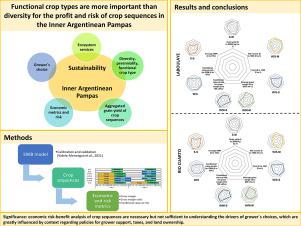Agricultural Systems ( IF 6.1 ) Pub Date : 2021-12-08 , DOI: 10.1016/j.agsy.2021.103333 H. Videla-Mensegue 1 , O.P. Caviglia 2 , V.O. Sadras 3

|
CONTEXT
Over the last 250 years, many natural ecosystems in South America, including the Inner Pampas of Argentina, evolved into extremely simplified agroecosystems. In the last 25 years, simplified soybean-based crop sequences have become widespread. Putative drivers of the wide adoption of this system include high soybean grain price, simplified agronomic management and low cost, but comparison of production, profit and risk in current and alternative crop sequences are lacking.
OBJECTIVE
Our aim was to compare the production, profit, and risk of seven crop sequences varying in their diversity, cropping intensity and the proportion of functional crop types.
METHODS
We modelled seven typical or feasible crop sequences for two locations with different rainfall and soil water holding capacity for a 50-yr period. Crop sequences included wheat (W) or fallow during winter and soybean (S) or maize (M) as single and double crops during summer, and were characterized with indexes of agrobiodiversity (ABDI, from 0.33 to 1.00), cropping intensity (from 0.40 to 0.83) and soybean proportion (SP, from 0 to 1.00).
RESULTS AND CONCLUSIONS
W/M-M had the highest and S-S the lowest yield in both locations. The high yielding crop sequences had a lower stability of grain yield that those with a high proportion of soybean (S-S and W/S-S). Yield stability and CVaR (conditional value-at-risk) for gross margin and gross margin ratio were unrelated with ABDI. The prevalent, least diverse soybean monoculture (S-S) had the lowest cost and medium profit-risk metrics. Increasing the proportion of maize contributed to higher gross margin and gross margin ratio with a lower risk in some crop sequences. Crop sequences with high proportion of soybean (S-S and W/S-S) had low mean cost with a close to average CVaR. However, these were not the sequences with the highest gross margin or gross margin ratio. Our results demonstrated that functional crop types (cereal and legumes) were more important than diversity and cropping intensity for the profit and risk of crop sequences in the Inner Argentinean Pampas.
SIGNIFICANCE
Economic risk-benefit analysis of crop sequences is necessary but not sufficient to understanding the drivers of grower's choices, which are greatly influenced by context regarding policies for grower support, taxes, and land ownership.
中文翻译:

在阿根廷潘帕斯草原的生产力、利润和作物序列风险方面,功能作物类型比多样性更重要
语境
在过去的 250 年里,南美洲的许多自然生态系统,包括阿根廷的内潘帕斯草原,演变成极其简单的农业生态系统。在过去的 25 年中,基于大豆的简化作物序列已变得普遍。广泛采用该系统的推定驱动因素包括高大豆粮价、简化的农艺管理和低成本,但缺乏当前和替代作物序列的产量、利润和风险的比较。
客观的
我们的目的是比较七种作物序列的产量、利润和风险,它们的多样性、种植强度和功能作物类型的比例各不相同。
方法
我们模拟了 50 年期间降雨量和土壤持水量不同的两个地点的七个典型或可行的作物序列。作物序列包括冬季小麦 (W) 或休耕和夏季大豆 (S) 或玉米 (M) 作为单作和双作作物,并以农业生物多样性指数 (ABDI,从 0.33 到 1.00)、种植强度 (从 0.40到 0.83)和大豆比例(SP,从 0 到 1.00)。
结果和结论
W/MM 在这两个位置的产量最高,SS 产量最低。高产作物序列的谷物产量稳定性低于大豆比例高的作物(SS和W/SS)。毛利率和毛利率比率的收益率稳定性和 CVaR(条件风险价值)与 ABDI 无关。普遍的、最不多样化的大豆单一栽培 (SS) 具有最低的成本和中等的利润风险指标。增加玉米比例有助于提高毛利率和毛利率比率,同时在某些作物序列中风险较低。大豆比例高的作物序列(SS 和 W/SS)具有低平均成本,接近平均 CVaR。然而,这些并不是毛利率或毛利率最高的序列。
意义
作物序列的经济风险收益分析是必要的,但不足以了解种植者选择的驱动因素,这些驱动因素在很大程度上受种植者支持、税收和土地所有权政策背景的影响。











































 京公网安备 11010802027423号
京公网安备 11010802027423号